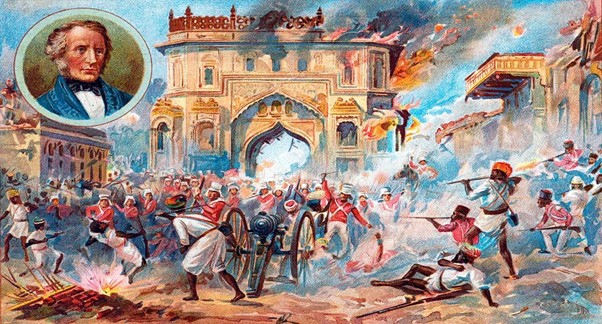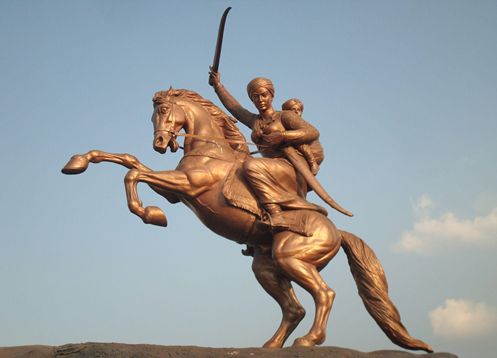

The Britishers first came to India as merchants and they got the Farman from the Mughal emperor. After some time they created their monopoly in trade with India. Other European countries left India and the British became powerful. The immense wealth and resources present in India made Britishers change their policy. Later they wanted to Colonise the whole of India and exploit as much as they could. After the fall of the Mughal empire, Britishers took control of Bengal by winning the battle of Palassy and the battle of Buxar. After these battles, Britishers gain total control of Bengal and started their administration. The East India Company became powerful and It took advantage of the internal squabble between local rulers.
The EIC started the policy of subsidiary alliance in which, the British army would fight on behalf of local rulers and the ruler had to pay the Britishers. Gradually by the subsidiary alliance, Britishers won many battles and no armies were strong enough to fight them. Britishers introduced many policies like subsidiary alliances and the Doctrine of Lapse and they were multiple reforms in laws and the military. All these changes were seen as exploitation, thus the old nobility with soldiers revolted against the British in 1857.

Revolt of 1857
Price's Patent Candle Company Limited, CC BY 4.0
There were various reasons for the revolt to happen −
The rulers and nawabs had lost their powers and a British resident was stationed in their courts to overlook the administration.
The nawabs had to disband their armies as they were in a subsidiary alliance with the Britishers.
Britishers captured many states with the policy of the doctrine of lapse, in which they did not right to property to the adopted son of the ruler. many states came into conflict over this policy, Jhansi and Awadh.
Britishers decided to end the Mughal tradition, and declared that after Bahadur Shah Zafar, no more Mughal kings will be named.
The Peasants and Landowners were levied high rates of taxes and even in drought, they had to pay the same amount. Many of the landowners became tenants because they could not pay taxes.
Brahman Soldiers were sent to Burma irrespective of their religion and those who refused to go by sea were severely punished and hanged.
Britishers discriminate against Indian soldiers and they did not allow Indians to become officers.
The new cartilage used in rifles was made of Cow and Pig fats and these rumours hurt the religious sentiments of Hindu and Muslim soldiers.
Multiple religious reforms were Introduced by Britishers and these reforms aggravated the orthodox Indians and old nobility.
The revolt of 1857 started with a sepoy mutiny. It converted into a nationwide revolt against British rule. The first rebellion happened in Meerut when on the 8th of April 1857, a young soldier was hanged for attacking his superior. This event acted as a spark which turned into a nationwide wildfire. Later soldiers at Meerut disobeyed the order and refused to use the cartridge as it had pig and cow fats.
On the 10th of May the soldiers rebelled against the British offices and killed them, they marched toward Delhi and other regiments also joined and killed the British officers. The soldiers started marching in the name of Mughal emperor Badahur Shah Zafar. The soldiers went to the Red fort and choose Bahadur Shah Zafar as their ruler and emperor of India.
After some time the news of this spread all over and regiments at different places came to revolt and joined troops at Delhi, Kanpur and Lucknow. After the sepoy revolt, people in villages and Zamindars and old chieftains also came against the British.
The old rulers who had lost their kingdoms to Britishers like Nana Saheb and Rani Laxmi Bai of Jhansi, Revolted against the English and won many battles. The British army was outnumbered and every village and Zamindar lifted weapons against them. Many old rulers won back their old kingdoms. In Bihar, Babu Kunwar Singh fought against the Britishers for months.

Rani Laxmi Bai
Dharmadhyaksha, CC BY-SA 3.0
The Indian rulers had gained their old kingdoms back and won some battles against the Britishers, but this was momentary, Britishers had called backup from England and passes new and harsh laws for those who supported the rebellion. In September 1857, Britishers captured bahadur shah Zafar and sent him to prison in Rangoon. Britishers adopted hard measures and took Lucknow in 1858 and Rani Laxmi Bai was killed in battle. Gradually they gain control of the revolt and after this massive revolt many changes were introduced by the British government to stop the revolts in future −
In 1858 the power was transferred from the East India Company to The British Crown.
The Governor General was made Viceroy and a council was made to help him in administration.
All rulers and chieftains were assured to be never attacked as long they accept the sovereignty of the Queen.
The proportion of Indian soldiers was reduced.
Britishers chose not to interfere with religious laws.
The revolt of 1857 was the retaliation of Indian masses against the British for the first time. There were several causes for this rebellion and the soldiers' role in the revolt was exceptional. People and old nobility came against the exploitation of British raj and it was quite successful for some time, but due to no powerful central authority and less planning, the revolutionaries lost and again British gained control.
Q1. What was the immediate cause of sepoy mutiny?
Ans. The immediate reason for mutiny was the presence of pig and cow fat in the new cartridge of rifles. The Hindu and Muslim both refused to use that cartridge.
Q2. Who were the famous rulers who fought in 1857?
Ans. The soldiers mutined and marched to Delhi in the name of Mughal emperor Bahadur Shah Zafar. Other rulers were Nana sahib, Rani Laxmi Bai, Tatiya Tope and others who fought against the British.
Q3. What was the aftermath of 1857?
Ans. The biggest change done in British rule was that the power was transferred to The British Crown from the EIC.
Q4. What religious reforms were introduced by the Britishers before 1857?
Ans. The laws were introduced to ban Sati practice, widow remarriage and the new laws were introduced to make religious conversion easily. Britishers tried to convert people to Christianity.
Q5. Why did peasants help sepoys in revolt?
Ans. Peasants were exploited by the high rate of taxes and most of them had lost their land and worked as tenants. They saw the opportunity to fight against exploitation in 1857.